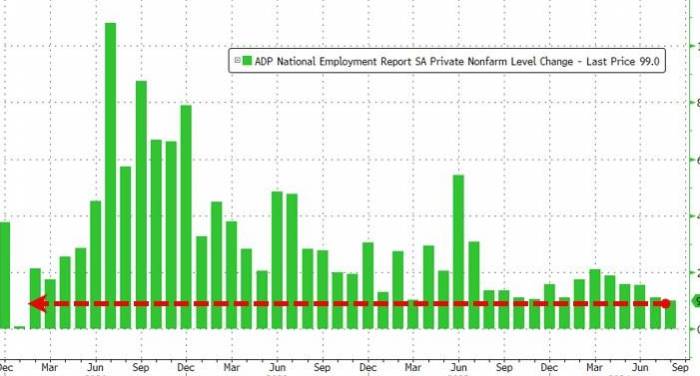On the eve of the release of the highly anticipated non-farm payroll data, the ADP employment figures, which are often seen as a precursor to the "official" non-farm data, unexpectedly showed a significant slowdown, indicating that there is still much uncertainty in the U.S. labor market. This has fueled expectations for a substantial interest rate cut by the Federal Reserve in September.
On September 5th, in collaboration with the Stanford Digital Economy Lab, the ADP Research Institute released data showing that the U.S. ADP employment increased by 99,000 jobs in August, marking the lowest record since January 2021 and significantly below the expected 145,000 jobs, with the previous figure being 122,000 jobs.
Nela Richardson, Chief Economist at ADP, wrote in the report:
After two years of substantial growth, the downward trend in the U.S. job market has slowed our hiring rate below normal levels. The next indicator to watch is wage growth, which is stabilizing after a significant slowdown post-pandemic.
Following the release of the data, recession expectations made a comeback, and the likelihood of a substantial rate cut by the Federal Reserve in September increased, causing U.S. Treasury yields to plummet and the U.S. dollar index to drop in the short term.
Advertisement
The CME FedWatch Tool indicated that the probability of a 25 basis point rate cut in September fell to 55%, while the possibility of a 50 basis point cut rose to 45%.
Earlier in the week, employment indicators also sent negative signals.
According to a report released by the U.S. Department of Labor on Wednesday, the number of job vacancies in July also reached the lowest point since January 2021. Furthermore, outplacement firm Challenger, Gray & Christmas reported on Thursday that last month was the worst August for layoffs since 2009, and 2024 has also been the slowest year for hiring since tracking began in 2005.
However, the ADP data showed that despite a significant slowdown in hiring, multiple industries increased their recruitment in August, with only a few reporting actual layoffs.
The unemployment benefit claims data released immediately after the ADP report on Thursday showed that the number of first-time claims for unemployment benefits in the U.S. for the week ending August 31 was 227,000, which was less than the expected 230,000. The number of continued claims for unemployment benefits for the week ending August 24 was 1.838 million, also below the expected 1.869 million, with both indicators showing a slight decrease from their previous values.The number of people applying for unemployment benefits has decreased, which may help alleviate concerns that the labor market is deteriorating.
Layoffs have improved, and wages continue to rise.
Specifically, in August, only three industries carried out layoffs, while the other seven industries increased hiring:
Among them, the professional and business services sector laid off 16,000 people, the manufacturing industry laid off 8,000 people, and the information services sector laid off 4,000 people.
The education and health services sector added 29,000 jobs, the construction industry added 27,000 jobs, and other services added 20,000 jobs.
The financial activities sector also added 18,000 jobs, and the trade, transportation, and utilities sector added 14,000 jobs.
In addition, the mining industry added 8,000 jobs, and the entertainment industry added 11,000 jobs.
However, this is the weakest service sector employment growth since March 2023, and the growth in manufacturing employment has also slowed down.
Wages continue to rise, but the increase is still lower than before. ADP data shows that the annual salary of employees in their positions increased by 4.8%, roughly the same level as in July.Will the Non-Farm Payrolls Announcement Tomorrow Clash with ADP's?

It is noteworthy that ADP's new employment additions have been significantly lower than the non-farm data for 10 out of the past 12 months.
The latter will be released by the U.S. Bureau of Labor Statistics on Friday and is expected to be the final nail in the coffin for a rate cut in September. The possibility of the two sets of data contradicting each other cannot be ruled out.
The market widely predicts that the non-farm employment figure for August will increase by 161,000, higher than the 114,000 in July, with the unemployment rate slightly dropping to 4.2%.
ADP reported that it has rebenchmarked its data based on the quarterly employment and wages census, resulting in a reduction of 9,000 jobs in August. A similar adjustment by the U.S. Bureau of Labor Statistics showed that non-farm employment was overestimated by 818,000 from April 2023 to March 2024. ADP will adjust the annual data in February 2025.
The market anticipates that a worsening employment situation will force the Federal Reserve to cut rates at the meeting on September 17-18, and a rate cut has become an almost certain event.
The key question lies in the magnitude of the rate cut, and current market pricing indicates that there is still a high probability that the Federal Reserve will cut rates by 25 basis points in September, with a cumulative reduction of 100 basis points by the end of the year.
Comments